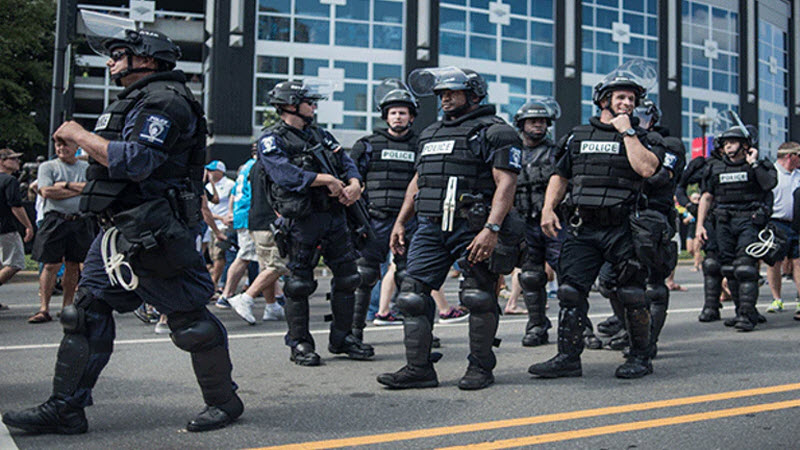

By Noe Herrera
UNITED KINGDOM – A new study published by a longtime British medical journal Saturday suggests that the number of deaths attributed to police violence in the U.S. is significantly higher than what is officially reported.
https://www.thelancet.com/journals/lancet/article/PIIS0140-6736(21)01609-3/fulltext#seccestitle10
“The burden of fatal police violence is an urgent public health crisis in the USA. Mounting evidence shows that deaths at the hands of the police disproportionately impact people of certain races and ethnicities, pointing to systemic racism in policing. Recent high-profile killings by police in the USA have prompted calls for more extensive and public data reporting on police violence,” said The Lancet.
The respected journal added, “This study examines the presence and extent of under-reporting of police violence in U.S. Government-run vital registration data, offers a method for correcting under-reporting in these datasets, and presents revised estimates of deaths due to police violence in the USA.”
In the recent wake of highly publicized police violence, including the outrage following George Floyd’s murder, people have protested and demanded an end to police brutality. In fact, the situation has become so widespread that the American Public Health Association has referred to police violence as a public health issue.
According to The Lancet, a peer-reviewed journal, there were an estimated 30,800 deaths “from police violence between 1980 and 2018” – 17,100 more deaths than what is reported by the US National Vital Statistics System (NVSS).
17,100 more deaths than what is reported by the US National Vital Statistics System (NVSS).
This means that the U.S. NVSS underestimated the number of deaths attributed to police violence by 55.5 percent, according to the Lancet study.
Most concerning, however, is the disproportionate number of police-related fatalities in the Black, Hispanic, and Indigenous populations, said the Lancet.
The Lancet data shows that non-Hispanic Black people experienced a mortality rate that was 3.5 times higher than that of non-Hispanic White people. Hispanic people and non-Hispanic Indigenous people experienced 1.8 times higher mortality rate than non-Hispanic White people.
The Lancet states, “systemic and direct racism, manifested in laws and policies as well as personal implicit biases, result in Black, indigenous, and Hispanic Americans being the targets of police violence.”
The Lancet used an “open-source methodology” to uncover the disparity between the number of deaths found in the public database and what was reported.
The study also identified factors that lead to the inaccurate official reports including unknowledgeable certifiers who fail to report police violence, conflicts of interest, and a survey where 22 percent of National Association of Medical Examiners “reported having been pressured by an elected official or appointee” to change the cause of death.
The Lancet argues that “the USA must replace militarized policing with evidence-based support for communities, prioriti(z)e the safety of the public, and value Black lives.” Moreover, police violence statistics must improve if health and government officials are to promote and design policies that would significantly reduce police brutality.
The Lancet noted that despite the comprehensive analysis of public information regarding police-violence-related deaths, more information is needed to attain a complete understanding about the effects of policing in society. A missing piece that should be investigated is the actual number of non-fatal injuries caused by police violence.
The Lancet maintained that “Racial bias in policing does not exist in a vacuum: it follows the pattern of anti-Black racism in the criminal justice system throughout the USA’s history. Police forces should exist to enforce laws that protect public safety, but throughout the USA’s history, police have been used to enforce racist and exploitative social orders that endanger the safety of the most marginalized groups in society.
“Some of the earliest examples of policing include the capture of runaway slaves, dismantling labor strikes and movements, and stopping riots, protests, or other expressions of social rage. In the post-slavery South, the police stopped organi(z)ers, threatened and beat protestors, denied protest permits, and did not protect demonstrators from mobs that bombed and killed them,” according to The Lancet summary.
“Today,” The Lancet adds, “U.S. police are heavily militarized, and fatal police violence disproportionately affects Black, Indigenous, and Hispanic people. Police are trained that any interaction can turn deadly and that they should react as such.
“Heavily armed officers can dangerously escalate situations that never needed violent interventions.
and that federal programs “provide the police with military equipment and outfit officers with lethal weapons that are unnecessary to protect their communities.”
The Lancet noted that during the George Floyd protests in 2020, “which were in direct response to racist police violence, The Guardian documented 950 instances of police violence against civilians and journalists,” including “more than 500 instances of the police using less-lethal rounds (rubber bullets), pepper spray, and tear gas; 60 instances of unlawful assembly to arrest protesters; and 19 of permissiveness to white supremacists, when not showing the same restraint towards demonstrators.”
The Lancet added that “Accountability and transparency in policing are lacking, as evidenced by ongoing problems with under-reporting. Police officers who kill civilians are rarely charged with a crime; Mapping Police Violence reports that in 2017, of 1,147 deaths, officers were charged with a crime in 13 cases, or one percent of the time.”
The report pointed out that “Police violence and racism in policing in the USA are not new or unexplained problems; they are the current manifestations of a system that was built to uphold racial hierarchy for most of the USA’s history.”
Finally, the study, said The Lancet, “has some limitations. First, this study does not calculate or address non-fatal injuries inflicted by the police. This topic is crucial to understanding the full burden of police violence and should be examined in future studies. We also excluded police officers killed by civilians and executions from our analysis of police violence. These data can be found elsewhere and should be analy(z)ed Separately.”

